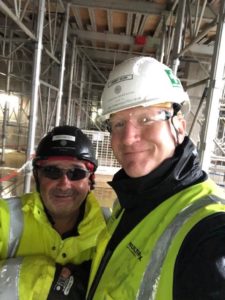From the military to safety and health has become a well-trodden career path for many and, increasingly, employers in OSH are taking advantage of a scheme to support the journey.
 To get an insight, SHP spoke to two veterans, former Company Sergeant Major and Warrant Officer Jimmy Quinn, who served with the Scots Guards and Royal Electrical and Mechanical Engineers and ex-RAF Regiment gunner, Scott Mathie.
To get an insight, SHP spoke to two veterans, former Company Sergeant Major and Warrant Officer Jimmy Quinn, who served with the Scots Guards and Royal Electrical and Mechanical Engineers and ex-RAF Regiment gunner, Scott Mathie.
Jimmy, Senior Health and Safety Manager at global construction firm Multiplex, is using his term as President of the Institution of Occupational Safety and Health (IOSH) to raise awareness of and build new communities for veterans in safety and health. Jimmy recently discussed plans for his presidency in a recent episode of the Safety & Health Podcast.
Scott is currently splitting his time between being a firefighter and Managing Director of his own training and consultancy firm, 1st Choice Safety. And he is one of a growing number of businesses in the safety and health sector to become forces friendly employers and signatories of the Armed Forces Covenant.
But first, what prompted both men to begin careers in safety?
“I didn’t understand what health and safety was as a solider but I knew people who did it,” said Jimmy. “Because I had spent some of my career as an instructor, and had the presentation skills, I wanted to put them to good use. I remember attending a health and safety course and sitting there, thinking, ‘I could do just as good a job as this instructor.’
“Someone heard me talking about a course I had delivered on a conference call and said, ‘you should do this, teach the good word of health and safety’. It was Simon Donnelly, a veteran and an IOSH fellow. He has mentored me since the beginning of my health and safety career.”
For Scott, the discipline and thought processes of the two uniform services, the RAF and the fire service, lent themselves to safety.
“It is about the risk to benefit,” he said. “If you were engaging the enemy, you would risk assess. Is this a risk worth taking? This mindset lends itself to firefighting, do you go into that burning building? And so it is with the field of safety and health.”
Understanding hazards
For both Jimmy and Scott, the military helped to prepare them for a career in safety and health. “To put it simply, it’s just the discipline needed for both careers,” said Scott. “It’s pointless putting something in place with safety if nothing gets followed through. You prepare and then you follow through as planned.
“Yes, you need to be someone who can handle the unexpected, but also someone who gets the value of planning well, and then being able to deliver.”
For Jimmy, the Army gave him a good understanding of hazards. “As a Company Quartermaster Sergeant, I was required to attend a course, and that allowed me to transfer to a Level 3 qualification in OHS,” he said. “I then had an understanding of the practicalities of what safety and health management systems were. Today, the army is looking to employ 75 health and safety advisors in the garrisons, and I would imagine other armed forces will replicate this going forward.”
Transferrable skills

Jimmy Quinn
Jimmy and Scott agree that the armed forces gives you skills you can use in safety and health. “You’re people-facing, you’re able to interact,” said Jimmy. “You have loads of soft skills, including communications and working as part of a team. Safety, like the military, is about recognising hazards and being able to make decisions. It’s about the ability to see the value of training and have the skills to assimilate into a team.”
For Scott, he transferred his organisational skills, discipline, teamwork and camaraderie to leading a safety team.
“I need to be able to work with other safety experts who have their own specialisms, such as mental health or safety in construction,” he said. “My current role is about building a team of specialists who can work together, and this has a lot of similarities with my RAF work.”
The main challenges
Making the transition from the military to civvy street wasn’t easy for either man as they forged their careers in safety.
“One of the biggest challenges for me was Imposter Syndrome” said Scott. “A lot of people in the military come out and don’t think they can do anything else. You spend 25 years being a trained soldier with a skillset that you think is quite specific.
“You don’t realise you have these transferrable skills that can help you to be successful outside the bubble of the military. You have a lot more to offer than you appreciate. It’s important not to forget that.”
Jimmy said: “I only knew one language, the army language. I expected things to be done right now and very competently. I expected that I was working with people as professional, or more professional than me. Everyone would be thinking the same. You are, to a degree, institutionalised in the army and trained to think as one.”
The former Warrant Officer says he had to create a new ideology in civvy street. “I had been in the army from the age of 17 to 42 and I knew nothing else,” he said. “I had to do an apprenticeship as a civilian. It was very challenging mentally and emotionally. I cut myself off. But then I joined IOSH networks and found other ex-military. I embraced that and found my way a bit. If I hadn’t have reached out, I would have become lost.”
Advice on making the transition
Making the move from the armed forces to a civilian career can be a challenging time. And the advice, in one word, is simple: Plan.
“If you’re coming to the end of your full career, plan two to three years ahead,” said Jimmy. “Reach out to veterans through the veterans network. Talk about what you feel you would like to do, and then start creating a plan up to the last day of service.
“You need to look at utilising your resettlement grants properly. In this day and age, if you want to get into health and safety look at online courses. And use your resettlement leave perhaps to attach to local authorities or companies that would like your assistance as an ambitious, new health and safety advisor. Really think about the skills you’ve got from the armed forces, and try to use that trade as well.”
Scott said: “Get your head into planning before you leave and what’s available to you after your leave. Use your resettlement grants and make sure you take all the advice available on matters such as housing.
“You come out of this protective bubble when you leave the military. I left home and went straight into the military, so I never had that life experience of being a civilian who had to find somewhere to live, find a dentist and a doctor, etc. So think this sort of thing through in good time to be prepared for when you do leave.”
Supporting other veterans

Scott Mathie
Today, both veterans are forging successful careers in safety and health, and are now looking to support other ex-military personnel.
Scott Mathie’s company is a signatory of the Armed Forces Covenant, and Scott is now supporting ex-RAF Regiment gunner Stephen Peake as he begins a career in safety and health.
“I’ve taken quite a lot of comfort from working with other ex-military people who have been doing it longer than I have,” said Scott. “There’s quite a good community of safety people who have come from the military.”
Steve is using his Enhanced Learning Credits (ELC) grants to invest in online courses with Nebosh, including the national general certificate in occupational safety and health, which is a route to membership of IOSH.
“My long-term plan is to become an IOSH member,” said Steve. “I think I’ll make a success of being a safety trainer. I quite like talking. I like standing up and speaking in front of people.
“I am in the process of applying for and paying for courses to get me started. Scott has guided me quite well. I think sometimes we think we’re still in the military. We know our word is our bond and we are fairly reliable with each other. He’s been a good role model, someone I can sound off to. We bounce off each other.”
Meanwhile, Jimmy is using his position as IOSH President to increase awareness of veterans in health and safety and support young people entering into the profession.
“I’ve set up working groups within IOSH’s Council to create the detail surrounding these two issues, and we’re looking at creating an IOSH LinkedIn Group for veterans, which I hope your readers would join if interested in a safety career,” he said.
“This would be a pre-cursor to building more networking opportunities in health and safety for former military.”
Click here to find out more about the Armed Forces Covenant.
Advance your career in health and safety
Browse hundreds of jobs in health and safety, brought to you by SHP4Jobs, and take your next steps as a consultant, health and safety officer, environmental advisor, health and wellbeing manager and more.
Or, if you’re a recruiter, post jobs and use our database to discover the most qualified candidates.

 To get an insight, SHP spoke to two veterans, former Company Sergeant Major and Warrant Officer Jimmy Quinn, who served with the Scots Guards and Royal Electrical and Mechanical Engineers and ex-RAF Regiment gunner, Scott Mathie.
To get an insight, SHP spoke to two veterans, former Company Sergeant Major and Warrant Officer Jimmy Quinn, who served with the Scots Guards and Royal Electrical and Mechanical Engineers and ex-RAF Regiment gunner, Scott Mathie.

I just wanted to say hello. I also spent 22 years in the REME, and left as an Artificer Sergeant Major. I did the H&S Officers course before leaving, and NEBOSH General Certificate after leaving. I am currently studying for the Diploma.
My Service experience has been invaluable in my H&S career, and many of the skills and characteristics built up in the forces have served me just as well in civi street.
It is good to see others do well after leaving their old lifestyle.
Hi,
I am ex forces and have my full NCRQ Diploma L6 in applied Health and Safety and am Grad IOSH. I have been trying for a while to get into H&S role and still looking in the Essex area.
Same here, I was a Royal Engineer Warrant Officer who has become a Safety and Quality Manager. We lost crown exemption in the forces so each unit had to have a Safety Manager and representatives, it was a bit of the unknown at first but we soon got to grips with it. My army training stood me in good stead for all my roles since leaving the forces.
I too have gone down that route from the military to the fire service and then to occupational health and safety but my journey started way back when H&S was an infant. During my years in the army I was afforded the opportunity to advance my skills and this lead me to teaching fellow signallers their trade and on leaving the army in 1972 naturally moved into another uniformed service in the fire service. It was around this time that H&S became the buzz word but the fire service were exempt so we continued our own systems. Eventually the FS… Read more »
This is a great article. Some of the best Facilities, Transport and SHE professionals I’ve ever come across throughout my career have been ex-forces. Right attitude, GREAT communicators, organisers, admin, etc… the list goes on
I spent over 24 years in RN finishing my career as a Chief Stoker in the Submarine Service. I spent my last couple of years ashore implementing safety and quality management systems in a multi fabrication workshop in Faslane. Since then I worked for 3 Ship Management companies as a Safety, Quality and Environmental Manager. I completed both Nebosh Diplomas for Safety and Environment a couple of years after the end of my Naval career. I retired early in December 2019 after 22 years in my various companies. I still maintain my CMIOSH and MCQI membership but enjoying retirement too… Read more »
I did 33 years in the RAF Regiment prior to leaving in 2011, I am now a Chartered Member of IOSH and have been working in H&S for 9 years now. I would recommend it as a career to all veterans as it matches our skill set, it’s not about the paperwork, it’s about ensuring the measures are put in place on the ground and that everyone understands the measures are there to keep them safe at work.